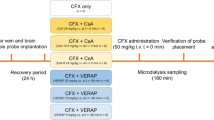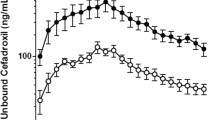Abstract
Purpose. Previous literature has suggested the absence of an effective barrier between the nasal mucosa and the brain for compounds administered via the nasal route. These experiments were conducted to elucidate the role of the blood-brain barrier efflux transporter P-glycoprotein (P-gp) in attenuating delivery of P-gp substrates to the brain after nasal administration in mice.
Methods. Brain uptake of several radiolabeled P-gp substrates, was measured in P-gp-deficient and P-gp-competent mice following nasal instillation. Additional experiments were performed to assess the potential for enhancing brain uptake by inhibiting P-gp with intranasal rifampin.
Results. All substrates examined were measurable in brain tissue within 2 min. Substrate accumulation in P-gp-deficient mice was higher than in P-gp-competent animals; the degree to which P-gp attenuated brain uptake after nasal administration was similar to that during in situ brain perfusion. Co-administration of rifampin enhanced brain uptake of relevant substrates, and resulted in complete elimination of P-gp-mediated transport for 3H- verapamil.
Conclusions. P-gp attenuates brain accumulation of intranasally-administered P-gp substrates. Thus, biochemical components of the blood-brain barrier, such as efflux transporters may influence brain penetration after nasal administration. Co-administration of a P-gp inhibitor enhances the brain uptake of relevant substrates, suggesting that the transporter barrier functions may be reversible.
Similar content being viewed by others

REFERENCES
M. W. Brightman. The anatomic basis of the blood-brain barrier. E. Neuwelt, (ed). Implications of the Blood-Brain Barrier and its Manipulation, volume 1. Plenum Publishing Corp., New York, 1989.
H. S. Chow, N. Anavy, and A. Villalobos. Direct nose-brain transport of benzoylecgonine following intranasal administration in rats. J. Pharm. Sci. 90:1729-1735 (2001).
A. Hussain, R. Kimuara, and C. H. Huang. Nasal absorption of testosterone in rats. J. Pharm. Sci. 73:1300-1302 (1984).
M. Dahlin, U. Bergman, B. Jansson, E. BjÖrk, and E. Brittebo. Transfer of dopamine in the olfactory pathway following nasal administration in mice. Pharm. Res. 17:737-742 (2000).
H. S. Chow, Z. Chen, and G. T. Matsuura. Direct transport of cocaine from the nasal cavity to the brain following intranasal cocaine administration in rats. J. Pharm. Sci. 88:754-758 (1999).
A. Minn, S. LeClerc, J. M. Heydel, A. L. Minn, C. Denizot, M. Cattarelli, P. Netter, and D. Gradinaru. Drug transport into the mammalian brain: the nasal pathway and its specific metabolic barrier. J. Drug Target. 10:285-296 (2002).
A. A. Hussain. Intranasal drug delivery. Adv. Drug Deliv. Rev. 29:39-49 (1998).
L. Hastings and J. Evans. Accumulation of Cd (II) in the CNS depending upon the route of administration: intraperitoneal, intratracheal, or intranasal. Fund. Appl. Toxicol. 19:275-278 (1992).
S. Perlman, N. Sun, and E. M. Barnett. Spread of MHV-JHM from nasal cavity to white matter of spinal cord. Transneuronal movement and involvement of astrocytes. Adv. Exp. Med. Biol. 380:73-78 (1995).
R. G. Thorne, C. R. Emory, T. A. Ala, and W. H. I. I. Frey. Quantitative analysis of the olfactory pathway for drug delivery to the brain. Brain Res. 692:278-282 (1995).
L. Illum. Transport of drugs from the nasal cavity to the central nervous system. Eur. J. Pharm. Sci. 1:1-18 (2000).
S. Mathison, R. Nagilla, and U. B. Kompella. Nasal route for direct delivery of solutes to the central nervous system: fact or fiction? J. Drug Target. 5:415-441 (1998).
R. H. Enting, R. M. Hoetelmans, J. M. Lange, D. M. Burger, J. H. Beijnen, and P. Portegies. Antiretroviral drugs and the central nervous system. AIDS 12:1941-1955 (1998).
G. Lee, S. Dallas, M. Hong, and R. Bendayan. Drug Transporters in the Central Nervous System: Brain Barriers and Brain Parenchyma Considerations. Pharmacol. Rev. 53:569-596 (2001).
T. Sakane, M. Akizuki, S. Yamashita, T. Nadai, M. Hashida, and H. Sezaki. The transport of a drug to the cerebrospinal fluid directly from the nasal cavity: the relation to the lipophilicity of the drug. Chem. Pharm. Bull. (Tokyo) 39:2456-2458 (1991).
T. Seki, N. Sato, T. Hasegawa, T. Kawaguchi, and K. Juni. Nasal absorption of zidovudine and its transport to cerebrospinal fluid in rats. Biol. Pharm. Bull. 17:1135-1137 (1994).
S. Doppenschmitt, P. Langguth, C. G. Regardh, T. B. Andersson, C. Hilgendorf, and H. Spahn-Langguth. Characterization of binding properties to human P-glycoprotein: development of a [3H]verapamil radioligand-binding assay. J. Pharmacol. Exp. Ther. 288:348-357 (1999).
C. Dagenais, C. Rousselle, G. M. Pollack, and J. M. Scherrmann. Development of an in situ mouse brain perfusion model and its application to mdr1a P-glycoprotein-deficient mice. J. Cereb. Blood Flow Metab. 20:381-386 (2000).
C. Dagenais, J. Zong, J. Ducharme, and G. M. Pollack. Effect of mdr1a P-glycoprotein gene disruption, gender, and substrate concentration on brain uptake of selected compounds. Pharm. Res. 18:957-963 (2001).
D. Lawrence. Intranasal delivery could be used to administer drugs directly to the brain. Lancet 359:1674(2002).
W. H. Frey. Bypassing the blood-brain barrier to deliver therapeutic agents to the brain and spinal cord. Drug Deliv. Technol. 2:46-49 (2002).
R. G. Thorne, C. R. Emory, T. A. Ala, and W. H. I. I. Frey. Quantitative analysis of the olfactory pathway for drug delivery to the brain. Brain Res. 692:278-282 (1995).
S. Mathison, R. Nagilla, and U. B. Kompella. Nasal route for direct delivery of solutes to the central nervous system: fact or fiction? J. Drug Target. 5:415-441 (1998).
A. Minn, S. LeClerc, J. M. Heydel, A. L. Minn, C. Denizot, M. Cattarelli, P. Netter, and D. Gradinaru. Drug transport into the mammalian brain: the nasal pathway and its specific metabolic barrier. J. Drug Target. 10:285-296 (2002).
J. Gu, Q. Y. Zhang, M. B. Genter, T. W. Lipinskas, M. Negishi, D. W. Nebert, and X. Ding. Purification and characterization of heterologously expressed mouse CYP2A5 and CYP2G1: role in metabolic activation of acetaminophen and 2,6-dichlorobenzo-nitrile in mouse olfactory mucosal microsomes. J. Pharmacol. Exp. Ther. 285:1287-1295 (1998).
V. Longo, M. Ingelman-Sundberg, G. Amato, A. Salvetti, and P. G. Gervasi. Effect of starvation and chlormethiazole on cytochrome p450s of rat nasal mucosa. Biochem. Pharmacol. 59:1425-1432 (2000).
J. A. Bond, J. R. Harkema, and V. I. Russel. Regional distribution of xenobiotic metabolizing enzymes in respiratory airways of dogs. Drug Metab. Dispos. 16:116-124 (1988).
P. G. Gervasi, V. Longo, F. Naldi, G. Panattoni, and F. Ursino. Xenobiotic-metabolizing enzymes in human respiratory nasal mucosa. Biochem. Pharmacol. 41:177-184 (1991).
M. A. Wioland, J. Fleury-Feith, P. Corlieu, F. Commo, G. Monceaux, J. Lacau-St-Guily, and J. F. Beraudin. CFTR, MDR1 and MRP1 immunolocalization in normal human nasal respiratory mucosa. J. Histochem. Cytochem. 48:1215-1222 (2000).
J. Zong. P-glycoprotein and Brain Uptake of Pharmaceuticals. Doctoral dissertation, University of NorthCarolina, Chapel Hill, North Carolina, 2002.
Q. Qu and F. J. Sharom. FRET analysis indicates that the two ATPase active sites of the P-glycoprotein multidrug transporter are closely associated. Biochemistry 40:1413-1422 (2001).
Author information
Authors and Affiliations
Corresponding author
Rights and permissions
About this article
Cite this article
Graff, C.L., Pollack, G.M. P-Glycoprotein Attenuates Brain Uptake of Substrates After Nasal Instillation. Pharm Res 20, 1225–1230 (2003). https://doi.org/10.1023/A:1025053115583
Issue Date:
DOI: https://doi.org/10.1023/A:1025053115583



